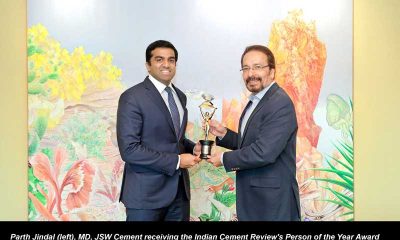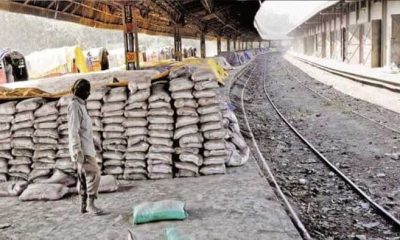Environment
Water transport is the largest cost reduction opportunity in cement logistics
Published
7 years agoon
By
admin
SUMIT BANERJEE, former Vice Chairman, Reliance Cement and Ex MD&CEO, ACC Ltd, says it is only a matter of time before cement companies evince interest in waterways and coastal transportation for competitively moving cement.
How has inland or coastal water transportation evolved over time?
From the early days of human civilisation, habitats and trade centres developed around rivers. This was no accident. Rivers provided a source of water, the elixir of life; helped irrigate lands for farming and provided an easy solution for sanitation (although unacceptable by today?s standards). On top of all that, rivers gave humans an avenue for transportation of people and merchandise. However, as newer modes of transport were invented, we favoured railways and roadways over riverine carriage of goods, evidently because we wanted to move things faster, and also away from rivers deeper into the hinterland.
As we started neglecting our traditional waterways, they deteriorated in terms of navigability, due to a variety of reasons such as indiscriminate construction of barrages, bridges and dams and consequent siltation, reclamation of river banks, inadequate investments in de-silting and in terminals, geopolitical controversies regarding sharing of waters between countries, etc.
Altogether, the effect of all these factors has been to push the concept of inland water transportation (IWT) into oblivion, at least in our country. Some other countries have fared better. The Fjords in Norway or the waterway systems in Pittsburgh/Great Lakes area in USA have excellent infrastructure for water transportation. In Germany, IWT constitutes 20 per cent [WB, 2005] and in Bangladesh it is 32 per cent [Rahman Mushfequr, 1994] of the total domestic goods movement. In Norway, it is reported to be 42 per cent. However, in India, it has become a very marginal part indeed (0.15 per cent) [Raghuram G, 2004]. Evidently, we have a lot to do.
How is inland water transport relevant today?
Water transport is the largest cost reduction opportunity in cement logistics. Empirically, we say that rail transport costs half of road transport, on per ton – km basis. Water transport, in turn, would cost half of rail transport, simply because it consumes substantially lesser amount of fossil fuel. So, clearly, IWT is highly relevant from a cost perspective, and as the cost of energy goes up, this cost differential is going to go up. It obviously makes business sense for a nation to focus on IWT, from cost or resource conservation points of view. This is single largest opportunity in front of cement companies to make a dent in their transportation costs, and thereby improve their competitiveness. But there is another dimension to this – that of climate change.
Out of all the global greenhouse gases emitted, 13-14 per cent are caused by transportation. If we can make a sizeable dent in this component of GHG, we can, as nations, contribute more to the global effort in climate mitigation. After the recent Paris Agreement (CoP 21), it has become more important for countries like China and India to evolve development-friendly strategies for CO2 management. IWT has suddenly become doubly more meaningful in this context.
Which industries can benefit from IWT/coastal transport?
To determine this, we have to first acknowledge the weaknesses of IWT, which are its relative slow speed and limited reach, restricted to regions adjoining riverine routes. There will be many products (electronic items, white goods, semi-precious metals) whose prices are high enough to afford faster and costlier modes of carriage like road or even air. Contrast these with bulk commodities like coal, steel, cement, fertilisers, food grains, iron ore and such other items which are comparatively lower in prices, volumetric and bulky in size, heavy in weight, and large in quantity. In these cases, one will be ready to allow it to spend a few days more in transit, if that saves significant amount of freight. I think it is only a matter of time before cement companies will get interested in exploiting this route for competitively transporting coal, cement, gypsum, clinker, and similar commodities.
However, for this to happen meaningfully, the cement companies will need to plan their footprint keeping in mind water routes, coastal positions and terminals, and most importantly, the location of target markets. Companies like Ambuja Cement and Ultratech have done this well on the western coast.
What steps should the government take to popularise water transport?
This will not move without improved and all-year round navigability and availability of terminals and storage facilities. This is where government investment will have to come in by way of continuous dredging, in addition to building terminals and warehouses along the waterway routes. The move to announce more waterways as National Waterways is most welcome, but this has to be followed through with effective development of infrastructure, which will definitely pay back by way of user fees, over time, as IWT becomes popular with commodity players. We have seen that the last budget has provided for raising Rs 800 crore by way of tax-free infrastructure bonds, specifically for inland waterways, and this is a commendable beginning. In due course, it may be a good idea to allow companies accelerated depreciation (or some such incentive) for investments in barges and riverside godowns, terminals, material handling equipment and similar infrastructure needed for inland water transportation. Andhra Pradesh took a step forward, when the CM recently announced an incentive of Rs 0.25/ton of water borne cargo, with the aim to achieve a 5 per cent share for IWT in the state.
Minister of Roads and Transport, Shri Gadkari said that at present there are only 5 inland waterways and his government has identified 106 more, and now these 111 waterways are being developed as National Waterways. He said that his government plans to construct 2000 water ports.
I feel that is the way to go!
Concrete
Filtration can help to control climate change
Published
4 days agoon
April 16, 2024By
admin
Niranjan Kirloskar, Managing Director, Fleetguard Filters, elaborates on the importance of filtration and its profound impact on efficiency, longevity and environmental sustainability.
Tell us about the core principle of filtration.
Filtration is segregation/separation of matter by density, colour, particle size, material property etc. Filtration is of four basic types:
- Separation of solids from gas
- Separation of solids from liquids
- Separation of liquids from liquids
- Separation of Solids from solids.
As applied to engines/equipment, the main objective of filtration is to purify the impurities and provide the desired fluid or air for enhanced engine/equipment performance in turn optimising their performance and life.
Can better filtration bring productivity to the work process? How?
Better filtration can improve the quality of application performance in multiple ways. Filtration improves engine performance as it filters and prevents dirt, dust, and debris from entering into the engine. This ensures that the quality of air or fluid that reaches the combustion chamber is as per the specific requirements of optimal performance of the engine. It also extends engine life by filtering out contaminants. Efficient filtration ensures optimal performance of the engine/equipment over its entire operating life. Filtration also improves fuel efficiency as a clean filter allows for a better air-fuel mixture in the engine, thus improving combustion efficiency, which in turn results in better fuel economy. It keeps emissions under control as fuels burn more efficiently leading to lesser harmful residue in the environment. Thus, to sum up, an optimal filtration solution ensures better performance, prolonged engine life and less hazardous waste in the environment.
What is the role of technology in the process of filtration?
Innovation, research and development as well as technology play a pivotal role in catering to the ever-evolving environmental norms and growing market demands. At FFPL we have NABL Accredited labs for testing, we have ALD Labs for design, and a team of R&D experts constantly working on providing advanced solutions to cater to the evolving market needs. We have robust systems and advanced technologies that make high-quality, high-precision products. Our state-of-the-art manufacturing facilities use advanced technologies, automation, robotics and also Industry 4.0 as applicable to provide the best products to our customers. To ensure each product delivered to market is of utmost precision, advanced quality equipment such as CMM, scanning systems and automated inspection technologies for real-time monitoring and quality control during the manufacturing of filtration systems and to comply with standard quality requirements are used.
Tell us about the impact of good filtration on health and the environment.
Good filtration of equipment is to the environment what a good respiratory system is to the body. There are various benefits of an efficient air filtration system as it improves the air quality by ensuring optimum combustion of fuel thereby reducing/controlling emissions to the environment. Efficient lube filtration ensures low wear and tear of the engine thereby extending life of the engines and maintaining optimal performance over the entire operating life of the engine. Efficient fuel filtration ensures low wear and tear of expensive and sensitive fuel injection thereby ensuring perfect fuel metering resulting in best fuel efficiency and saving of precious natural resources. This efficient filtration can help to control climate change as it reduces the carbon footprint due to combustion in the environment.
Can your products be customised and integrated with other machinery?
Fleetguard Filters have been known as a leading solutions provider for decades. With relevant experience and close customer relations, we understand the market/applications requirements and develop solutions to address the pressing technical challenges our customers face concerning filtration solutions. Filters can be customised in terms of size, shape and configuration to fit specific requirements. Customised filters can be designed to meet critical performance requirements. Filtration systems can be designed to integrate seamlessly with any auto and non-auto application requirements.
What are the major challenges in filtration solutions?
Major challenges faced in filtration solutions are:
- With every emission regulation change, filtration requirements also keep changing.
- Engines are being upgraded for higher power ratings.
- Space for mounting filtration solutions on vehicles/equipment is shrinking.
- For fuel injection systems, the water separation efficiencies are becoming more and more stringent, so are particle separation efficiencies.
- Due to next level filtration technologies,filtration systems and filter elements are becoming expensive, thereby increasing TCO for customers.
- Customers prefer higher uptimes and longer service intervals to ensure lower maintenance and operating costs.
We, at Fleetguard, strive continuously to ensure that all the pains experienced by our customers are addressed with the fit to market solutions. Balancing the cost of filtration solutions with their performance and durability can be challenging, especially where the requirements of high filtration standards are required. Also, wrong disposal methods for used filters can have environmental impact.
- –Kanika Mathur

Prince Pipes and Fittings Limited, in partnership with Ambuja Foundation, has launched a comprehensive water harvesting project in Chomu district of Rajasthan as part of its CSR initiative. The project aims to address water scarcity and enhance community resilience against water-related challenges. Ambuja Foundation will focus on setting up over 50 rooftop rain rainwater harvesting systems to provide a reliable source of water for 250 people. Additionally, efforts will be made to revive 2 village ponds, creating 10,000 cubic meters of water storage capacity, and to rejuvenate groundwater by implementing check dams, farm ponds and farm bunding. The project also includes educating the local community on water conservation techniques and promoting conscious water usage. This initiative seeks to support farmers through the government’s subsidies to install sprinkle irrigation systems at a minimal cost, while also contributing to livestock strengthening and promoting community ownership.

Dr SB Hegde, Professor, Jain University, Bangalore, and Visiting Professor, Pennsylvania State University, USA, discusses how the cement sector is battling substantial carbon emissions and resource depletion, and embracing advanced technologies to mitigate its environmental impact.
In the relentless pursuit of urbanisation and infrastructure development, the cement industry finds itself at a pivotal intersection of ambition and responsibility. This foundational sector has long been synonymous with progress and growth, providing the bedrock for modern cities and industries. Yet, beneath its seemingly unyielding façade lies a profound challenge – the environmental footprint it leaves behind. Cement production, for its high carbon emissions and resource consumption, is now compelled to rewrite its narrative. The cement industry needs to become more sustainable using advanced technology. In this article, we will explore the world of cement production and discover new solutions that can change its future.
Considering traditional cement production is a major emitter of CO2, accounting for around 8 per cent of global greenhouse gas emissions. It consumes a vast amount of limestone, a finite resource, and contributes to deforestation and habitat destruction in limestone-rich regions.
Supplementary cement materials (SCMs) and creative ideas like Calcined Clay Clinker (LC3) are making a big difference. These different materials are transforming the way things are done. For example, in India, where the cement industry is one of the largest carbon emitters, LC3 technology, which incorporates calcined clays into cement, has been demonstrated to reduce CO2 emissions by up to 30 per cent and substantially decrease energy consumption during the clinker production process. By 2050, it is estimated that the implementation of such alternative materials could help the cement sector reduce its global CO2 emissions by up to 16 per cent.
The cement industry because of its energy-intensive processes, consuming approximately 5 per cent of the world’s total energy and contributing significantly to greenhouse gas emissions.
Waste heat recovery systems, a pivotal technology, are setting an example for sustainability. A case study from a cement plant in Germany showed that waste Innovations in Sustainability Dr SB Hegde, Professor, Jain University, Bangalore, and Visiting Professor, Pennsylvania State University, USA, discusses how the cement sector is battling substantial carbon emissions and resource depletion, and embracing advanced technologies to mitigate its environmental impact. heat recovery reduced energy consumption by approximately 20 per cent and cut CO2 emissions by 1.6 million tons annually. This not only demonstrates the environmental benefits but also underscores the economic advantages of such innovations.
Furthermore, the industry is adopting alternative fuels, often derived from waste materials. Lafarge Holcim, one of the world’s largest cement producers now utilizes alternative fuels in 37 per cent of its cement plants. This has resulted in an estimated reduction of 2.2 million tonnes of CO2 emissions annually, showcasing the transformative potential of sustainable fuel sources.
The electrification of kiln systems is a transformative step towards sustainability. While the shift to electrification is in its nascent stages, there are promising examples. Heidelberg Cement, a global leader in building materials, has set ambitious targets to electrify its cement production processes. By leveraging renewable energy sources, such as wind and solar, the company aims to reduce CO2 emissions by 30 per cent within the next decade. These concrete numbers underscore the industry’s commitment to low-carbon electrification.
Hybrid and flash calcination technologies offer compelling statistics as well. For instance, a pilot project using flash calcination technology in the Netherlands yielded a 25 per cent reduction in CO2 emissions compared to traditional rotary kilns. These numbers highlight the potential of disruptive technologies to reshape the cement industry.
This article is like a clear road map with real examples, explaining how the cement industry is becoming greener and more sustainable. By using technology, the cement industry wants to find a balance between moving forward and taking care of the environment. It’s showing how an industry can change to become more sustainable, strong and responsible for the future.
CURRENT TECHNOLOGIES

1. Alternative raw materials: The cement industry’s traditional reliance on limestone as a raw material is undergoing a transformation. The incorporation of alternative materials like fly ash, slag or pozzolans is a sustainable approach. For example, the use of fly ash in cement production can reduce CO2 emissions by up to 50 per cent compared to traditional Portland cement.
2. Energy efficiency: Improving energy efficiency is crucial. Waste heat recovery systems can significantly reduce energy consumption. For instance, waste heat recovery in cement plants can lead to a 20-30 per cent reduction in energy consumption.
3. Carbon Capture and Storage (CCS): CCS is a promising technology. In Norway, the Norcem Brevik cement plant has successfully demonstrated the capture of CO2 emissions, which are then transported and stored offshore. This technology can capture up to 400,000 tonnes of CO2 annually.
4. Use of alternative fuels: The shift towards alternative fuels can significantly reduce carbon emissions. For example, the use of alternative fuels in the European cement industry results in an average substitution rate of about 40 per cent of conventional fuels.
5. Blended cements: Blended cements, combining clinker with supplementary cementitious materials, can lead to lower emissions. For example, the use of slag and fly ash can reduce CO2 emissions by up to 40 per cent.
INNOVATION FOR THE FUTURE
1. Carbon Capture and Utilisation (CCU): CCU technology is still emerging, but it shows great potential. Innovations like carbon mineralisation can convert CO2 into stable mineral forms. Carbon Engineering, a Canadian company, is working on a direct air capture system that can capture one million tons of CO2 annually.
Feasible CCS technologies for the cement industry include:
a. Post-combustion capture: Capturing CO2 emissions after combustion during clinker production using solvents or adsorbents.
b. Pre-combustion capture: Capturing CO2 before combustion, often used with alternative fuels.
c. Oxy-fuel combustion: Burning fuel in an oxygenrich environment to facilitate CO2 capture.
d. Chemical looping combustion: Using metal oxides to capture CO2 during the calcination process.
e. Carbonation of alkaline residues: Capturing CO2 using alkaline residues from other industrial processes.
f. Integrated Carbon Capture and Storage (ICCS): Directly capturing CO2 from the cement production process.
g. Underground storage: Transporting and storing CO2 underground in geological formations.
h. Enhanced Oil Recovery (EOR): Injecting captured CO2 into depleted oil reservoirs.
i. Mineralisation: Converting CO2 into stable mineral forms for potential use or storage.
The cement industry can reduce emissions by adopting these technologies, but cost, energy, and infrastructure challenges must be addressed for widespread implementation. Collaboration among stakeholders is crucial for successful CCS integration.
2. Biomimicry in cement design: Researchers are exploring biomimetic materials inspired by nature. For example, a company called BioMason uses microorganisms to grow cement-like building materials, reducing energy use and emissions.
3. 3D printing of cement: 3D printing technology offers precise and efficient construction, reducing material waste. In a study, 3D-printed concrete structures used 40-70 per cent less material compared to traditional construction methods.
4. Blockchain for supply chain transparency: Blockchain technology ensures transparency and traceability. It is already being used in supply chains for various industries, including cement. By tracing the origin of raw materials and tracking production processes, it ensures sustainability compliance.
EVALUATING AND IMPLEMENTING SUSTAINABLE TECHNOLOGIES
1. Life Cycle Assessment (LCA): LCAs assess environmental impacts. For instance, a comparative LCA study found that geopolymer concrete (an alternative to traditional concrete) had 36 per cent lower carbon emissions compared to Portland cement.
2. Cost-benefit analysis: Considerations of initial investments and ongoing operational costs are paramount. Studies show that the implementation of waste heat recovery systems can pay back their initial costs in as little as two years, leading to long-term savings.
3. Regulatory compliance: Stricter emissions standards are being enforced globally. The European Union, for instance, has set ambitious emissions targets for the cement industry, mandating a 55 per cent reduction in CO2 emissions by 2030
4. Scalability: The scalability of technologies is critical for industry-wide adoption. Technologies like blended cements and waste heat recovery systems are already scalable, with global cement companies actively implementing them.
5. Stakeholder engagement: Engaging stakeholders is essential. For example, Holcim, a leading cement manufacturer, has partnered with NGOs and local communities to ensure sustainable practices and community involvement in their projects.
In conclusion, the cement industry is on a transformative path towards sustainability, driven by technological innovations. By embracing alternative raw materials, enhancing energy efficiency, and exploring cutting-edge solutions like carbon capture and utilization, the industry is reducing its environmental impact. The future holds even more promise, with biomimetic materials, 3D printing and blockchain enhancing sustainability.
Evaluating and implementing these technologies necessitates comprehensive assessments, cost-benefit analyses, regulatory compliance, scalability and stakeholder engagement. The industry’s commitment to sustainability not only addresses environmental concerns but also aligns with societal values and expectations, setting the stage for a greener and more responsible future for cement production.
REFERENCES:
1. NIST. (National Institute of Standards and Technology) Role of NIST in Sustainable Cements.
2. International Energy Agency. Cement Technology Roadmap 2018.
3. Gassnova. Longship – CO2 Capture, Transport, and Storage.
4. European Cement Association. Cembureau.
5. CSI. (Cement Sustainability Initiative) Slag Cement and Concrete.
6. Carbon Engineering. Direct Air Capture and Air To Fuels.
7. The University of New South Wales. Alternative Cement Discovery Set to Reduce Carbon Emissions.
8. BioMason. BioMason Technology.
9. NCCR Digital Fabrication. DFAB House Project.
10. IBM Blockchain. IBM Blockchain Solutions for Supply Chain.
11. ScienceDirect. Life Cycle Assessment of Geopolymer Concrete.
12. Energy.gov. Heat Recovery Technologies.
13. EU Climate Action. EU Climate Action: Climate Targets for Cement Industry.
ABOUT THE AUTHOR:

Dr SB Hegde is an industrial leader with expertise in cement plant operation and optimisation, plant commissioning, new cement plant establishment, etc. His industry knowledge cover manufacturing, product development, concrete technology and technical services.

RAHSTA to showcase cutting-edge road construction tech, says NCC Director

RAHSTA will drive road construction innovation: Sundaresan

New appointment at TMEIC

Social Impact Award for Ambuja Cements

UCWL unveils new plant in Dabok, Udaipur

Environment Ministry revises rules of solid waste management

M-sand boards new terrain

Process and quality optimization in cement plant.
Concrete: A Highly Sustainable Building Material













